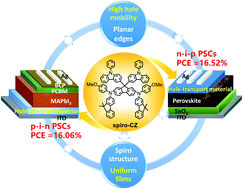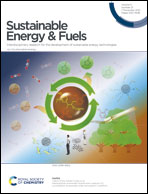Facile fluorene-based hole-transporting materials and their dual application toward inverted and regular perovskite solar cells†
Abstract
Over the past decade, two typical device architectures of perovskite solar cells (PSCs) have been developed as n–i–p regular devices (r-PSCs) and p–i–n inverted cells (i-PSCs). Hole-transporting materials (HTMs) play a vital role in facilitating hole extraction and transport in PSCs. However, a large number of reported HTMs are only applicable for either r-PSCs or i-PSCs owing to the quite different design strategies of the corresponding HTMs. Herein, a spiro-structured configuration was employed to construct lower symmetry molecules. Planar electron-rich carbazole and twisted triphenylamine units as electron donors were incorporated into the spiro-core and denoted as spiro-CZ and spiro-TPA, respectively. The decreased symmetrical conformation contributes to high glass transition temperatures and supports thermally stable amorphous HTM films. Compared with spiro-TPA, spiro-CZ featuring carbazole donors realized more effective capability of hole extraction. As a result, a high power conversion efficiency (PCE) of 16.52% was achieved by n–i–p structured PSCs with spiro-CZ, significantly exceeding that of the reference spiro-TPA (8.47%). However, contrary to expectations, p–i–n structured PSCs with undoped spiro-CZ and spiro-TPA obtained a comparable PCE of 16.06% and 15.79%, respectively. Note that these PCEs were shown to outperform that of commercial dopant-free spiro-OMeTAD (10.48%) and PEDOT:PSS (13.74%) under the same conditions. Moreover, the doped spiro-CZ-based r-PSCs delivered a good long-term device stability under ambient conditions. Overall, seeking lower symmetry molecules endowed with planar electron-rich units is a promising method to support the development of efficient universal HTMs toward i-PSCs and r-PSCs.



 Please wait while we load your content...
Please wait while we load your content...